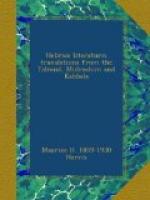Yet the legal does not form the whole of the Talmud, nor perhaps the part that would most interest the casual reader or the world at large. It is the dry, prosaic half. There is a poetic half, let us say a homiletic half, what we call Agada, as distinct from the legal portion called Halacha. The term Agada, “narrative,” is wofully insufficient to describe the diverse material that falls under this head, for it comprehends all the discursive elements that come up in the legal discussions in the old Babylonian and Palestinian academies. These elements are occasionally biographical,—fragments of the lives of the great scholars, occasionally historical,—little bits of Israel’s long tragedy, occasionally didactic,—facts, morals, life lessons taught by the way; occasionally anecdotic, stories told to relieve the monotony of discussion; not infrequently fanciful; bits of philosophy, old folk-lore, weird imaginings, quaint beliefs, superstitions and humor. They are presented haphazard, most irrelevantly introduced in between the complex discussions, breaking the thread that however is never lost, but always taken up again.
From this point of view the Talmud is a great maze and apparently the simplest roads lead off into strange, winding by-paths. It is hard to deduce any distinct system of ethics, any consistent philosophy, any coherent doctrine. Yet patience rewards the student here too, and from this confused medley of material, he can build the intellectual world of the early mediaeval Jew. In the realm of doctrine we find that “original sin,” “vicarious atonement,” and “everlasting punishment,” are denied. Man is made the author of his own salvation. Life beyond the grave is still progressive; the soul is pre-existent.
A suggestion of the wit and wisdom of the Talmud may be gathered from the following quotations:—
A single light answers as well for a hundred
men as for one.
The ass complains of cold even in July.
A myrtle in the desert remains a myrtle.
Teach thy tongue to say, “I do not
know.”
Hospitality is an expression of Divine
worship.
Thy friend has a friend, and thy friend’s
friend has a friend;
be discreet.
Attend no auctions if thou hast no money.
Rather flay a carcass, than be idly dependent
on charity.
The place honors not the man, ’tis
the man who gives honor to the place.
Drain not the waters of thy well while




